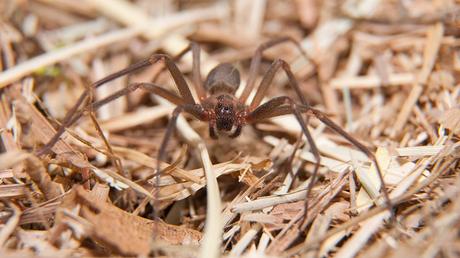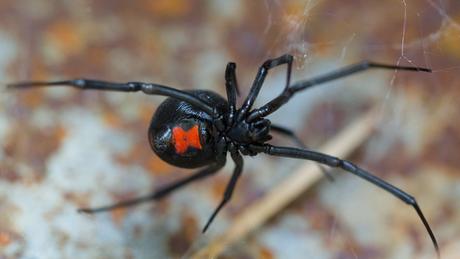Spider Habits
Spiders are not aggressive. In fact, they want to cloister themselves away from humans and other disturbances so they can quietly construct a web, catch food, mate, and generally carry on with life. They do not go out to hunt and attack humans. In fact, they want to avoid you as much as you wish to stay away from them.
Sometimes, though, accidental contact occurs. Spiders prefer dark places, including shoes, drawers, nooks, and corners. Pay attention to your environment before sticking your hands or feet anywhere. Take a moment to look around you, carefully shake out your shoes, and watch where you are reaching. Most types are not poisonous spiders, but three species in southern Louisiana are dangerous to humans.
 Brown Recluse
Brown RecluseThe Brown Recluse (Loxosceles reclusa) is typically different shades of brown in color, though variations can range from whitish to blackish gray. These spiders usually have a marking near their head resembling a violin, leading to other common names such as brown fiddler, violin spider, and fiddleback spider. Many other spiders, however, have a similar look, so take care what you touch, and, if in doubt, leave it alone. Interestingly, the abdomen of the brown recluse has many short, fine hairs that look like soft fur. As the name implies, they look for dark, dry places that are quiet, such as:
- Woodpiles
- Sheds
- Closets
- Garages
- Cellars
- Cardboard (probably resembles rotting wood, a favored environment)
- Drawers
- Shoes
- Behind baseboards and wall art
They seek to avoid contact and confrontation with humans, often choosing to run rather than fight. However, if they are cornered and cannot escape and feel threatened, they will bite. These poisonous spiders have venom that can cause significant injuries to skin tissue and may even lead to necrosis, or the premature death of living tissue cells.
If you are bitten, remain calm. Put the wound under cold water or ice, and get medical attention. You can start with poison control, but brown recluse bites should be taken seriously, and you probably will want to see a doctor right away. The good news, though, is that the brown recluse lives up to its name. Watch where you are putting feet and hands, and do not touch any spider that you suspect might be a brown recluse.
 Black Widow
Black WidowPerhaps the most feared spider in the world, black widows get their name from the occurrence of sexual cannibalism, as females sometimes eat males after mating, though this behavior may not occur in all species of so-called widow spiders. Furthermore, their venom is not regularly fatal to humans, though death can sometimes occur, especially in young children and the elderly. Females are most often dark, often shiny black, with a distinctive red hourglass shape on their abdomens. They produce silk-like strands that are sticky, and female black widows like to build webs near the ground or in holes burrowed out by animals. Generally, they seek dark, noiseless places where they will not be readily disturbed, like:
- Under wood and rubble piles
- Inside hollow stumps
- Crawl spaces
- Under stones
- Sheds and garages
Though they are poisonous spiders, black widows are not aggressive. They will not seek out humans to attack them. However, they will bite if they are startled and feel their life is threatened. Black widow bites can be painful when they do occur, and the venom contains a substance that can affect the human nervous system. Symptoms include abdominal cramps, muscle spasms, and intense muscular pain. Antivenom can alleviate some of the pain and mitigate other potential dangers. If bitten, apply a cold compress to the site and get medical help right away.
Brown Widow
Brown widows are thought to have originated in South Africa, but scientists are not certain. They have migrated to tropical regions around the world. They compete with black widows, and while not as poisonous as their cousins, they are more aggressive. They are interlopers, and only time will tell how the growing population of brown widow spiders affects the ecosystem. Brown widows often nest around buildings.
These poisonous spiders are varying shades of brown in color and sport a bright orange or yellow hourglass shape on the underside of the abdomen. Their venom, like the black widow’s, is also a neurotoxin, though the effect of brown widow venom is usually limited to the bite location and the nearby tissue, while the black widow’s venom creates systemic problems. Nonetheless, their bites should be taken seriously. If bitten, call poison control and, if necessary, seek medical attention.
The Bottom Line on Louisiana’s Poisonous Spiders
Brown widows may be the most aggressive of Louisiana’s three most poisonous spiders, but even they will not actively hunt humans and attack them. Be aware of your surroundings, especially in obvious places where these spiders might be, such as around piles of wood and rubble, in dark corners of sheds, basements, and garages, and under stones. Gently check shoes for any unexpected inhabitants, and look where you are reaching and putting your hands. These spiders only bite if you surprise them and they feel endangered. It is common sense, really. However, if you are concerned about growing populations, you may want to talk to Baton Rouge pest control experts about spider control. Respect their environment, teach children to look but not touch, and these spiders will likely, in turn, leave you alone.
